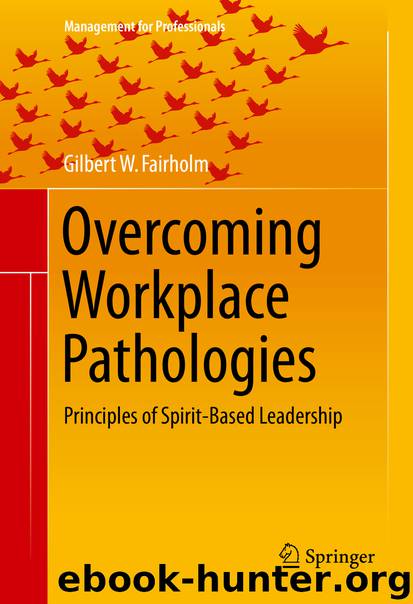Overcoming Workplace Pathologies by Gilbert W. Fairholm

Author:Gilbert W. Fairholm
Language: eng
Format: epub
Publisher: Springer International Publishing, Cham
7.1 Areas Where Leadership and the Idea of Tolerance Intersect
Perhaps one of the most deceptive redefinitions of foundational values and American ideals is the idea of tolerance for difference in others. Tolerance for others’ differences is a traditional and fundamental quality of effective leaders and workers—indeed for all people. Tolerance defined traditionally describes the idea of sensitivity to others’ differences (The American Heritage Dictionary 1994) and as such is a useful and often-used leadership tool. Formerly its de facto definition included the idea of equal freedom of expression, initially not only in religious matters but also in professional realms. As applied to the work community being tolerant allowed the leader to obtain the best contributions of time, talent, and skill from each coworker.
Intellectually—and over time—tolerance has advanced through several definitions. Walsham (2006, p. 233) notes that our present understanding of the word “toleration” may be very different from its historic meaning. Today tolerance is most often seen as a component of a laissez-faire worldview about human rights. Now the idea is that as long as no one is harmed or their fundamental rights are not violated, work community members should tolerate what most of its members may find disgusting, disgraceful, or even degrading. John Rawls, Robert Nozick, Brian Barry, and Will Kymlicka, among others advocate this perspective in varying degrees (see Oberdiek 2001, p. vi). Rawls’ theory of liberalism conceives of toleration as a pragmatic response to the fact of diversity. Diverse groups learn to tolerate one another by developing what Rawls calls “overlapping consensus.” He (1971, p. 216) defines this as the idea that individuals and groups with diverse metaphysical views will find reasons to agree about certain principles of justice that will include principles of toleration. Toleration continues to retain this meaning but only insofar as the persons to whom this word is directed agrees with the ideology of the speaker. To all others the opposite is true. That is, tolerance has come to mean acceptance of the point of view of some workers in the work community—be it a coworker or a subgroup, or an outside person or group. Workers with other views are seen as intolerant—i.e., close-minded to these “new” or different ideas. This current iteration of tolerance flows from the unwillingness of some workers to accept contrary opinions or beliefs. They are impatient of dissent or opposition and deny or refuse the right of choice or alternative opinion in others. And when thwarted they are inclined to persecute or suppress dissent. Thus, today so-called tolerant people are broad-minded, liberal open-minded, and progressive but only about certain points of view. Those who disagree with them are dogmatic, reactionary, opinionated, small-minded, and anachronistic.
As modern transportation and communication have brought all workers into closer proximity to different peoples and different ideas, there is greater need for tolerance defined traditionally. Traditionally tolerance is defined not just agreeing with one another, but rather showing respect for the essential humanity in every person (Ury 1999, p. 127). In the modern workplace the greater exposure to diversity both enriches worker’s lives and complicates them.
Download
This site does not store any files on its server. We only index and link to content provided by other sites. Please contact the content providers to delete copyright contents if any and email us, we'll remove relevant links or contents immediately.
Bullshit Jobs by David Graeber(3830)
Radical Candor by Kim Scott(2579)
I Am Right, You Are Wrong by Edward De Bono(2339)
23:27 by H. L. Roberts(2140)
Nomadland by Jessica Bruder(1955)
Average Is Over by Tyler Cowen(1758)
The Conflict Resolution Phrase Book by Barbara Mitchell & Cornelia Gamlem(1646)
Out of Our Minds: Learning to Be Creative by Ken Robinson(1629)
High-Impact Interview Questions by Victoria A. Hoevemeyer(1611)
The Ideal Team Player by Patrick M. Lencioni(1562)
An Everyone Culture: Becoming a Deliberately Developmental Organization by Robert Kegan & Lisa Laskow Lahey(1527)
The Asshole Survival Guide by Robert I. Sutton(1504)
Automatic Society by Bernard Stiegler(1462)
Who by Street Randy & Smart Geoff(1421)
Unleashed by Anne Morriss & Frances Frei(1421)
Who Moved My Cheese?: An Amazing Way to Deal With Change in Your Work and in Your Life by Johnson Spencer(1417)
42 Rules of Employee Engagement by Susan Stamm(1396)
96 Great Interview Questions to Ask Before You Hire by Paul Falcone(1354)
The Power of Disability by Al Etmanski(1286)
